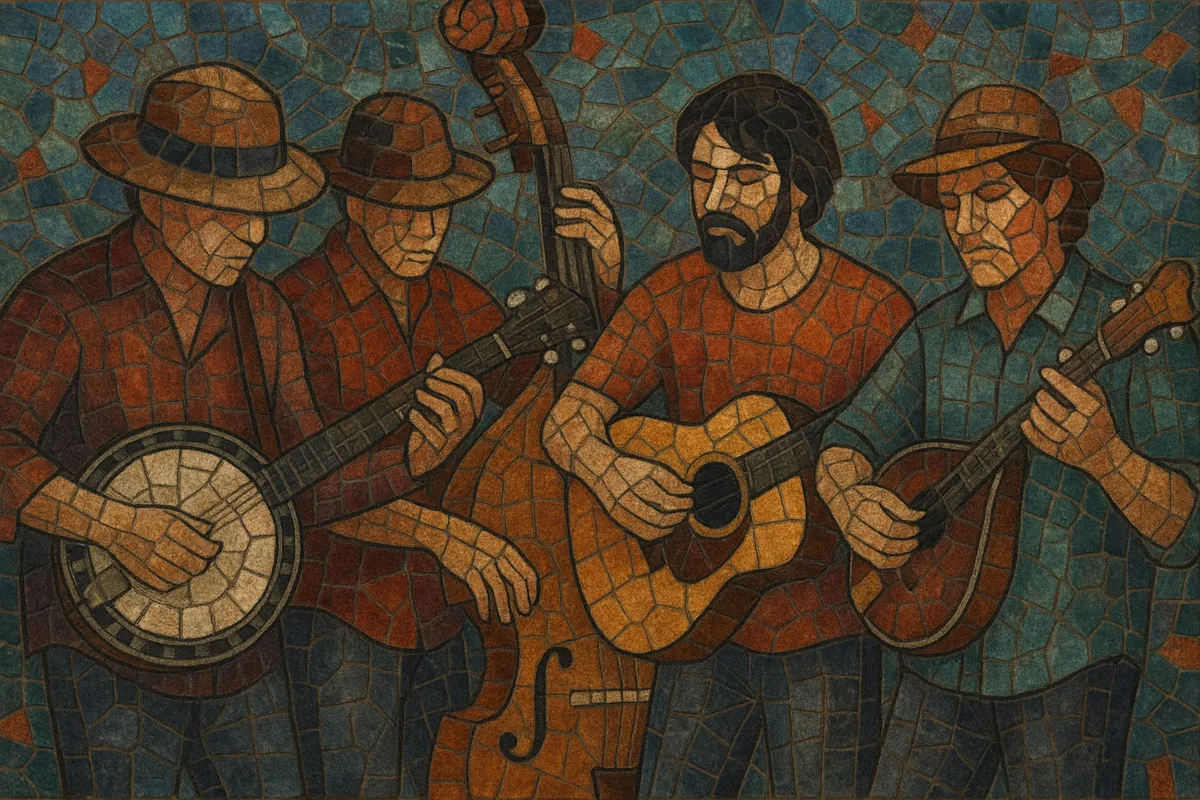Jamgrass is a hybrid of traditional bluegrass instrumentation and the expansive, improvisation-heavy aesthetics of jam band culture.
It keeps the acoustic core of bluegrass—banjo, mandolin, fiddle, guitar, and upright bass—while embracing extended solos, modal vamps, rhythmic detours, and spontaneous transitions between songs.
Unlike classic bluegrass, jamgrass often features drum kits, electric bass, keyboards, and effects, especially in live settings. Arrangements are flexible, with grooves stretching out to accommodate collective improvisation and call-and-response between instruments. The vibe is festival-ready: rootsy, virtuosic, danceable, and open-ended, encouraging audience participation and long-form setlist flow.
Jamgrass crystallized in the United States in the 1990s, drawing on the musical daring of 1970s progressive bluegrass (“newgrass”) and the improvisational ethos of rock jam bands. While innovators like Sam Bush and New Grass Revival had already stretched bluegrass harmonically and rhythmically, the 1990s festival circuit provided the perfect ecosystem for an even more improvisation-forward, dance-oriented acoustic sound.
Colorado’s scene (Telluride, Boulder) and other regional festival hubs nurtured bands that fused bluegrass chops with jam band setcraft. Groups such as Leftover Salmon and The String Cheese Incident normalized extended improvisations, segues between songs, and eclectic stylistic detours (country rock, Cajun, folk-rock) within an acoustic-heavy lineup. The term “jamgrass” stuck as audiences recognized the bluegrass foundation paired with long-form jams.
The 2000s saw rapid growth via relentless touring and the rise of destination festivals. Yonder Mountain String Band, Railroad Earth, Greensky Bluegrass, and The Infamous Stringdusters built large followings with high-energy shows, pristine picking, and exploratory improvisation. Production values increased, drum kits and amplification became more common on larger stages, and cross-genre collaborations flourished.
By the 2010s, jamgrass was a mainstay of the roots and jam festival circuits. The scene continues to blend tight songcraft with improvisation, attracting fans from bluegrass, Americana, and rock. Modern bands balance tradition (acoustic technique, fiddle tunes, high harmonies) with adventurous arrangements, modal jams, and dynamic setlist pacing, ensuring the style remains fresh and highly live-driven.
Start with a bluegrass core: acoustic guitar, banjo, mandolin, fiddle, and upright bass. Add dobro for color. For larger stages, consider drum kit, percussion, electric bass, and keyboards. Use microphones and pickups that preserve acoustic detail while allowing for dynamic, jam-band volume and effects.
Lean on bluegrass drive (2/4 or brisk 4/4) with the classic boom–chick feel, walking bass, and off-beat mandolin chops. Alternate with mid-tempo shuffles and backbeat grooves to create space for solos. Build sections around vampable riffs to enable extended improvisation and smooth segues between songs.
Compose with folk/bluegrass progressions (I–IV–V, ii–V, vi–IV–I–V) and modal centers (Mixolydian, Dorian) that facilitate long jams. Use clear head–solo–head structures, then insert open “jam windows” signaled by cues. Arrange dynamic arcs: start tight and thematic, expand into exploratory sections, then return to the hook.
Encourage conversation among instruments: trade eights, use call-and-response, and layer countermelodies under solos. Develop band cues for modulations, tempo lifts, and thematic teases. Keep solos melodically grounded in the tune’s motif before venturing into modal or rhythmic variations.
Write storytelling or road-tested narratives typical of Americana/bluegrass, but leave room for instrumental features. Prioritize singable choruses and strong harmonies to anchor exploratory sections. In live settings, plan setlists that balance songs, instrumentals, and medleys to maintain momentum.
Aim for clear, present acoustic tones; add tasteful reverb, slapback, or light overdrive on solos if using pickups. Preserve transients of picking and bowing. Onstage, use monitor mixes that spotlight rhythmic anchors (bass, mandolin chop) to keep extended jams tight.


